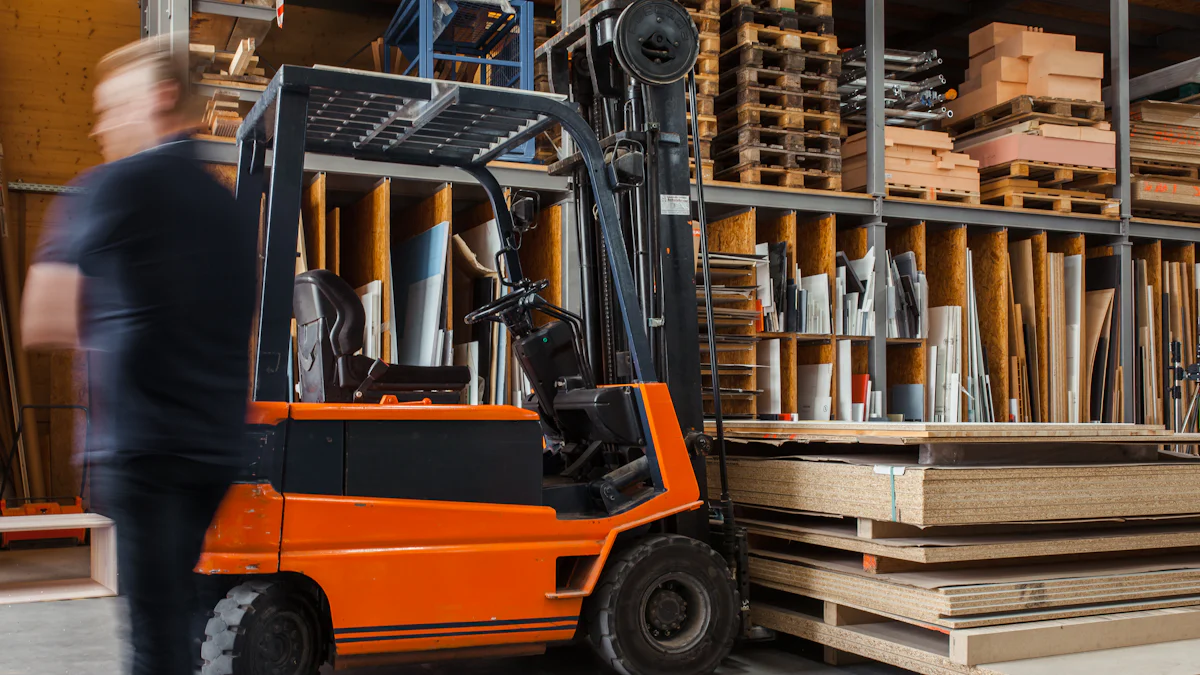
Proper pallet jack handling is crucial in warehouse operations to ensure safety and efficiency. When it comes to moving a pallet jack on an incline, the risks escalate significantly. Understanding the potential dangers associated with this task is paramount for all operators. In this blog, we will delve into the common mistakes made during such maneuvers and shed light on their severe consequences. By recognizing these pitfalls, individuals can enhance their awareness and adopt best practices to prevent accidents and injuries.
Mistake 1: Ignoring Weight Distribution

Understanding Weight Distribution
Proper weight distribution on a pallet jack is essential for safe operation. Neglecting this aspect can lead to instability and potential accidents. Operators must grasp the significance of weight distribution to ensure a smooth and secure maneuver.
Why Weight Distribution Matters
The balance of weight impacts the overall stability of the pallet jack. By distributing the weight evenly, operators can minimize the risk of tipping over and maintain control during movement. Understanding this principle is fundamental to safe operation.
How to Properly Distribute Weight
To achieve proper weight distribution, operators should position the load centrally on the forks. Placing heavier items at the bottom and lighter ones on top helps maintain balance. Additionally, securing the load properly prevents shifting, enhancing stability.
Consequences of Poor Weight Distribution
Neglecting proper weight distribution can result in hazardous situations that compromise safety in the warehouse environment. Operators must be aware of the potential risks associated with unevenly distributed loads.
Increased Risk of Tipping
When weight is not distributed correctly, there is a higher likelihood of the pallet jack tipping over, especially when navigating inclines or rough terrain. This poses a significant danger to both the operator and surrounding personnel.
Difficulty in Maneuvering
Improper weight distribution makes it challenging to maneuver the pallet jack effectively. Uneven loads can cause imbalance, leading to difficulties in steering and controlling the equipment. This not only hampers productivity but also increases the risk of accidents.
Mistake 2: Using Incorrect Techniques
Proper Techniques for Moving on an Incline
When moving a pallet jack on an incline, it is crucial to employ the correct techniques to ensure safety and efficiency. Following proper methods can significantly reduce the risk of accidents and enhance operational effectiveness.
Always Stand Uphill
Operators should always position themselves uphill when navigating inclines with a pallet jack. This strategic placement provides better control and visibility, minimizing the chances of mishaps during movement.
Pushing vs. Pulling
Experts recommend pulling the pallet jack when ascending inclines as this allows for improved access to brakes and enhances overall control. Conversely, pushing is more suitable for flat surfaces where maneuverability is less challenging.
Maintaining Control
Maintaining control over the pallet jack is paramount in ensuring a safe operation, especially on inclines. By using appropriate techniques such as maintaining a steady pace and being vigilant of surroundings, operators can navigate slopes securely.
Common Incorrect Techniques
Inadequate training or lack of awareness often leads to the utilization of incorrect techniques when operating a pallet jack on an incline. Recognizing these common mistakes is essential in promoting a culture of safety within warehouse environments.
Overexertion
One prevalent error among operators is overexerting themselves while moving a pallet jack on inclines. This can lead to fatigue and compromised judgment, increasing the likelihood of accidents. Employing proper techniques can prevent unnecessary strain and potential injuries.
Improper Foot Placement
Improper foot placement is another common mistake that hampers safe operation on inclines. Placing feet incorrectly can affect balance and stability, jeopardizing both the operator’s safety and that of others in the vicinity. Ensuring proper foot positioning is vital for secure maneuvering.
Mistake 3: Neglecting Safety Checks
Pre-Operation Safety Checks
Inspecting the Pallet Jack
Before initiating any operation involving a pallet jack, it is crucial to conduct thorough safety checks. Start by examining the equipment itself, ensuring there are no visible damages or defects that could compromise its functionality. Inspect the main steer wheels, forks, and fork rollers meticulously to guarantee they are in optimal condition for safe operation.
Checking the Incline Surface
Apart from inspecting the pallet jack itself, operators must also assess the incline surface where the equipment will be maneuvered. Look out for any irregularities or obstacles that could impede smooth movement. It is essential to ensure that the incline surface is stable and free from debris that might pose risks during operation.
Ongoing Safety Monitoring
Watching for Obstacles
During the operation of a pallet jack on an incline, continuous vigilance is paramount to identify and address potential hazards promptly. Operators should remain attentive to their surroundings, keeping an eye out for any obstacles or obstructions along the intended path of movement. By actively watching for obstacles, operators can prevent accidents and maintain a safe working environment.
Monitoring Load Stability
In addition to external factors, maintaining load stability is crucial for safe pallet jack operation on inclines. Operators must regularly monitor the stability of the load being transported, ensuring it remains balanced and secure throughout the maneuver. Any signs of instability should be addressed immediately to prevent accidents and ensure efficient workflow.
Mistake 4: Overloading the Pallet Jack
Understanding Load Limits
Manufacturer’s Guidelines
- Follow manufacturer’s guidelines for load capacity to prevent overloading.
- Check the pallet jack’s specifications to determine the maximum weight it can safely handle.
- Exceeding the recommended load limit can lead to equipment damage and safety hazards.
Calculating Safe Load Capacity
- Calculate the safe load capacity based on the weight of the items being transported.
- Ensure that the total weight does not surpass the pallet jack’s designated limit.
- Overloading can compromise stability and increase the risk of accidents in the workplace.
Risks of Overloading
Equipment Damage
- Overloading the pallet jack can cause wear and tear on its components.
- Excessive weight puts strain on the equipment, leading to potential malfunctions.
- Regularly exceeding load limits may result in costly repairs or premature replacement of parts.
Increased Accident Risk
- Operating an overloaded pallet jack elevates the chances of accidents occurring.
- Loss of control, tipping, or collisions are more likely when carrying excessive loads.
- Prioritizing adherence to load limits is crucial for maintaining a safe working environment.
Mistake 5: Inadequate Training and Awareness
Importance of Proper Training
Proper training is essential for pallet jack operators to ensure safe and efficient operation in warehouse environments. Without adequate training, operators may be unaware of the potential risks and proper handling techniques, increasing the likelihood of accidents and injuries.
Training Programs and Resources
- OSHA requires certification training for all facility workers operating pallet jacks to promote a culture of safety.
- Employers should provide comprehensive training programs that cover operational procedures, safety guidelines, and emergency protocols.
- Regular refresher courses and skill assessments are crucial to reinforce proper practices and address any gaps in knowledge or skills.
Hands-On Practice
- Practical hands-on practice is invaluable for operators to apply theoretical knowledge in real-world scenarios.
- Simulated exercises can help operators familiarize themselves with different operating conditions and challenges they may encounter.
- By engaging in hands-on practice regularly, operators can enhance their skills, confidence, and situational awareness when using pallet jacks.
Promoting Awareness and Vigilance
Maintaining a high level of awareness and vigilance is key to preventing accidents and ensuring a safe working environment. Operators must be alert, proactive, and well-informed to identify potential hazards and respond effectively to mitigate risks.
Regular Safety Meetings
- Conducting regular safety meetings provides an opportunity to discuss best practices, share experiences, and address safety concerns.
- These meetings facilitate open communication between management and staff regarding safety protocols, incident reporting, and continuous improvement initiatives.
- By fostering a culture of transparency and collaboration through safety meetings, organizations can strengthen their commitment to workplace safety.
Encouraging a Safety-First Culture
- Cultivating a safety-first culture involves instilling a mindset where safety is prioritized above all other considerations.
- Encouraging employees to report near misses, hazards, or unsafe practices promotes accountability and continuous improvement.
- Recognizing and rewarding individuals who demonstrate exemplary safety behavior reinforces the importance of vigilance and compliance with established safety standards.
Recapping the pivotal errors to steer clear of when handling pallet jacks on inclines is crucial. Emphasizing safety protocols and correct techniques is paramount for accident prevention. Encouraging the adoption of best practices ensures smooth pallet jack operations. Maintaining a secure working environment hinges on vigilance and adherence to safety guidelines. Remember, safety is a shared responsibility that safeguards both operators and workplace integrity.
Post time: Jun-29-2024
